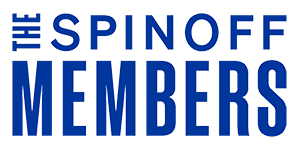Viva La Dirt League have been making YouTube videos for nearly a decade, and they’ve just launched their biggest series yet. Sam Brooks talks to the creators about what makes this channel so special – and successful.
If you watch the first video that Viva La Dirt League uploaded to their YouTube channel nine years ago – a Starcraft parody set to Blue’s ‘All Rise’ – the overwhelming feeling is that of goofy, earnest joy. In it, Viva La Dirt League founders Adam King, Alan Morrison and Rowan Bettjeman (along with two co-stars) sing along to the 2001 hit in an Auckland warehouse, swapping out the lyrics with references to an inexplicably popular game from 1999. It’s funny, and holds up a lot better than a decade-old music video parody has any right to.
The video has the hallmarks of a certain era of internet video (as does the group’s name, a reference to Starcraft with two words chucked on the start because “Dirt League” was taken). The production values aren’t especially high and it’s shot in the omnipresent, barely-furnished warehouse that seems to feature in every comedy video of the late 2000s. The costume design is best described as “already purchased”. There are only men on camera, so you can comfortably assume there’s no makeup team.
You get the feeling that it came about after someone asked a question starting with, “Wouldn’t it be cool if…?”.
Eleven years after that charming, low-budget video was uploaded to YouTube, Viva La Dirt League are continuing to follow that whim, just in front of a much larger audience. Their channel has 3.43 million subscribers on YouTube, and has amassed 860 million views in the past decade. The first episode of their latest series has been watched, as of this writing, almost 570,000 times.
With the exception of Rekt, a 2017 series funded by NZ on Air and YouTube’s Skip Ahead scheme, their success has been achieved outside the confines and structures of traditional media, which is currently in slow-mo freefall. Instead, they rely on their audience to keep them afloat. On Patreon, they have over 4,000 subscribers, contributing over $27,000 to the channel a month in exchange for exclusives and the warm feeling of supporting creators they like.
Adam King, a founder alongside Bettjeman and Morrison, describes the group as “online content creators”, perhaps one of the least descriptive word groupings in modern English, but it’s not inaccurate. “We make skit comedy, based primarily on nerd culture. It’s primarily video games, but also movies and TV.” When he describes the channel to anyone over the age of 40, he says the easiest comparison is Monty Python.
Viva La Dirt League started off with music video parodies and such, but their bread and butter for the past few years has been what King calls “logic parodies” – essentially looking at video games and deconstructing the logic. “For example, in fantasy games, if you get struck by an arrow or some magical spell hurts you and you’ve got half a limb missing, then you eat a piece of bread and that restores your health. What does that look like in real life?”
These logic parodies began with PUBG (PlayerUnknown’s Battlegrounds, the game that kicked off the battle royale craze) and have since included popular franchises like Apex Legends (peppier battle royale game), Red Dead Redemption (sad cowboy game) and Dark Souls (mean monster game).
D&D Logic is their latest series, and it’s their biggest yet. In “backstories”, several Dungeons and Dragons characters, in full costume and makeup, tell their increasingly ludicrous histories to each other. It’s a spot-on parody of overly eager tabletop players who craft backstories for their character that make no sense, especially given that characters tend to start these campaigns at level one.
The production values are nothing like that very first video, ‘Eight Pool (8 Pool) Music Video’, which now sits at nearly 800,000 views. The visuals in this new series are sharp as hell: the costumes look like they could’ve been pilfered from Amazon’s Lord of the Rings wardrobe before the show ran off to England, the makeup looks like it’s the kind you spend hours in a chair for, and the set looks closer to The Witcher than Medieval Times.
The group has also started another series on another channel (Viva La Dirt League D&D, 213K subscribers, 10 million views) where they will stream their own tabletop gaming sessions. Says King: “D&D has a lot of the similar kind of game logic that video games have. So we definitely saw the possibilities there, but then also Rob had been dropping a whole load of hints that we should do it as well.”
Rob is Robert Hartley, a full-time Dungeon Master. He both writes and stars in D&D Logic, but this isn’t his first appearance on the channel. “We played D&D together two years ago, and it went well,” he says of how the collaboration came about. “During that series, there were a couple of times when we were doing green screen cutaways of what their characters are experiencing in the real world, and because they were taking on the role of those characters, it meant that we could also take the mick out of the logic of the world.”
While the original trio are involved in D&D Logic, working with collaborators like Hartley allows them to take their foot off the pedal a little, says King. “We’ve seen the people that we’ve been collecting around us and going, ‘Holy crap! We’ve got an awesome, talented bunch of people!’ And they’ve got stories that they want to tell as well. We want to embody the ‘as the seas rises, all boats rises’ mentality, and foster lots of other voices in New Zealand to tell those stories.”
This series is their biggest yet, with a main cast of 10. The makeup and costume effects are as impressive as any broadcast (or streaming) fantasy show you might watch, and in some cases more impressive. The scale of the production impressed Hartley, who was writing and showrunning for the first time. “Because they’re successful, I already had an established costume and props department that I could talk to,” says Hartley. “I could tell them what I wanted, just put it out there, and they’d come back to me with images. It was my imagination literally coming to life.”
King is keen for that experience to continue as Viva La Dirt League continue to branch out. “We would love Viva to be a platform for creators to make awesome stuff in the future, and so at the moment we’re experimenting with getting some of our close key collaborators to make shows for us.” One of their next plans is for frequent collaborators Britt Scott-Clark and Ellie Harwood to make a logic series based on The Sims.
Especially notable about Viva La Dirt League, particularly within the niche they inhabit (nerds, video game and otherwise), is the immense audience support they enjoy. There’s the financial support, of course – those Patreon numbers don’t lie – but the genuine enthusiasm that floods through their YouTube comments is what makes you briefly believe the internet isn’t the cesspool it’s often made out to be.
King puts their good-natured fandom down to the global appetite for New Zealand comedy, but also to the specific relationships that a medium like YouTube creates. “One of the beauties of online content is that the creator-audience is so intertwined compared to TV or movies. You’re really creating an audience. We’re so happy that we’ve managed to create an audience that is very, very nice compared to some gaming audiences out there.”
Good vibes beget more good vibes, Hartley says. “It’s self-serving in a sense, because the people who do come in new might have this aggressive attitude, and the people in the community will call them out. I mean, it’s on YouTube. You can watch it for free! You don’t have to stay here and watch. If it’s not your thing, just leave. So the community keeps itself nice and friendly and encouraging.”
Content creation, as nebulous a term as that may be, has changed since Viva La Dirt League launched back in 2011. A content creator can be anything from a social media influencer, to an illustrator putting out artworks, to someone like yours truly, writing articles for an online magazine. While YouTube isn’t exactly traditional media yet, it’s not far off – “YouTuber” is a respectable job now, after all.
While King can see VLDL expanding into TikTok in the future – the channel has an account, but doesn’t yet make content specifically for the platform – he says they’re not looking to make a move into TV any time soon. “Traditional media to me is still something that has been either funded by a studio or funded by advertising, and that’s not how YouTube works. It’s funded by the audience, it’s funded by views, so that middleman doesn’t exist.”
While a potential pivot to TV is something they’ve discussed, the group is adamant they’re not interested. “I always say to people who want us to do that stuff” ‘I can see the love in your comment that you want us to do it, but deep in your soul, you don’t want us to do a Netflix show,’” says King. “We’re making what we want, getting paid for it, and you guys are getting it for free. Why would we make a show on Netflix when we’re doing exactly what we want here now?”
It’s a fair point. Their latest video has had over half a million streams in less than a week. Any local comedian, give or take Matafeo or Darby, would kill for those numbers. Hell, any of our networks would kill for those numbers for one of their shows. Why would Viva La Dirt League jump through the hoops of traditional media only to be met with more restrictions, a smaller audience, and ultimately, fewer chances to do the stuff they actually want to do?
Beyond the impressive numbers, the real achievement of Viva La Dirt League is the uplifting enthusiasm that runs through everything they do. That first video, which I maintain still holds up, has the kind of infectious joy that you only really get when people want to do something cool together. It’s been nine years, 869 videos and nearly a billion views, but the most remarkable thing about Viva La Dirt League isn’t that they’re so successful – it’s that they’re still having a shit-ton of fun doing exactly what they want to do.


